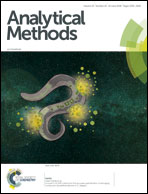Target regulated photo induced electron transfer of DNA-Cu nanoparticles and their application for the detection of the hepatitis B gene
Abstract
Despite the distinct features of polythymine (T)-templated copper nanoparticles (polyT-Cu NPs) as fluorescent probes for various biosensors, most of the reported methods involve labeling with an appropriate fluorescence quencher, or the addition of enzyme to digest the DNA-template. In this paper, the phenomenon of photo induced electron transfer (PET) between the polyT-Cu NPs and Guanine quadruplex (G4)–K+–hemin (horseradish peroxidase (HRP)–DNAzyme) complexes was found, and was applied for the fabrication of a “turn-on” target modulated fluorescence system for the sensitive determination of the HBV gene, without any labeling process or the addition of enzyme. Using optical and electrical experiments, the PET mechanism was investigated. In the detection process, the PET led to the quenching of the fluorescence of the polyT-Cu NPs, thus lowering the background; then in the presence of target DNA, a conformational change occurred, the PET was blocked and the fluorescence could be recovered. The developed strategy was highly sensitive for the detection of the HBV gene in the concentration range from 0.1 to 80 nM, with a low detection limit of 33.4 pM (S/N = 3). In addition, the novel method for specific DNA sequence detection was highly selective. Finally, this work was successfully utilized for the sensitive and label free fluorescence determination of the HBV gene in blood plasma samples.



 Please wait while we load your content...
Please wait while we load your content...